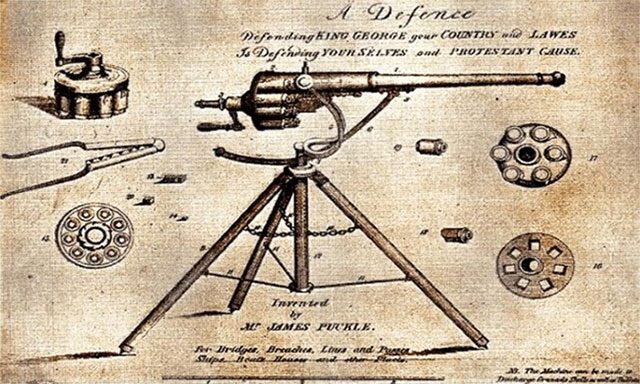The Puckle Gun is a type of firearm capable of firing 9 rounds continuously, invented by James Puckle in 1718. However, the Puckle Gun was not commercially successful due to issues with its firing mechanism and low accuracy.
Most people believe that the first true machine gun in the world is the Gatling Gun, invented in 1862 by Richard Gatling and used during the American Civil War, causing unprecedented damage compared to any other weapon of its time. However, a hand-cranked, revolving gun was invented nearly 150 years earlier known as the Puckle Gun.

Design of the Puckle Gun. (Photo: Alamy).
Born in 1667, James Puckle was a writer, inventor, and lawyer from London with a passion for religion and defense. At that time, the West was embroiled in a major conflict with the Ottoman Empire, a powerful state dominating Southeastern Europe, North Africa, and Western Asia, which was eyeing the rest of Europe. The Ottoman Empire, adhering to Islam, sought to convert any territory it conquered.
Like the Vikings, the Ottomans used small boats to attack merchant ships along the Mediterranean coast, a vital trade route for the entire world. On these small boats that could evade heavy cannons on British and Spanish ships, pirate crews would board and seize control of the vessels, stealing valuable items on board.
Given that cannons were quite primitive and took a long time to reload, dealing with pirates using long-range weaponry was nearly impossible. England needed an advanced weapon. James Puckle had an idea. His new invention, the Puckle Gun, would use a cylindrical barrel attached to a lever to feed ammunition into the gun, capable of being cranked quickly to fire 9 shots per minute. Such a rapid-firing weapon seemed extremely superior compared to muskets that could only fire 3 shots per minute in the hands of a skilled marksman.
The Puckle Gun is considered the first machine gun in the world. It fired standard round bullets, but for the Muslims, the ammo was converted to square bullets to increase lethality. The design was introduced for testing at Woolwich in 1717, but the ammunition firing mechanism proved unreliable. This was a critical factor for achieving continuous fire. Puckle applied for a patent and marketed the gun in 1721. However, the firing mechanism’s issues rendered the design commercially unsuccessful.


















































